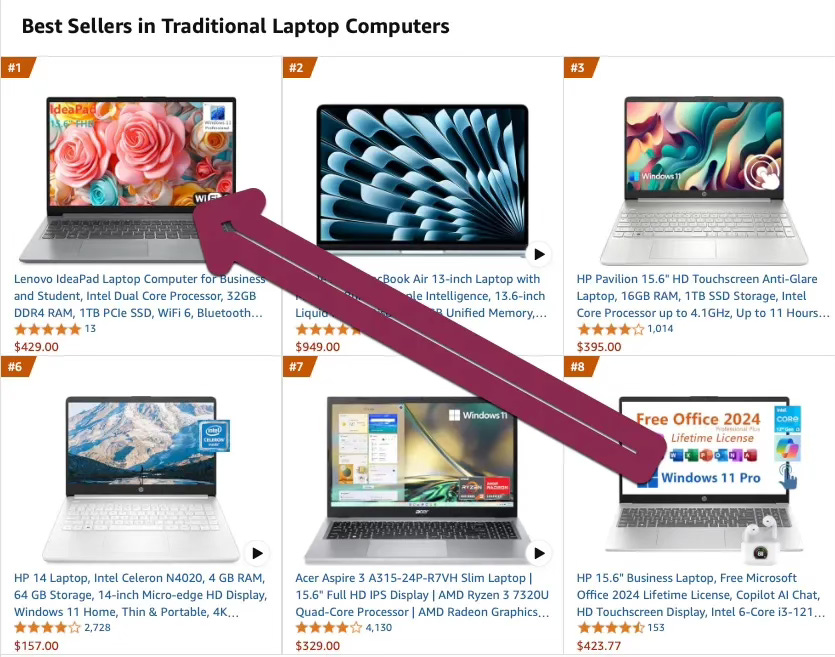Amazon’s product listings can’t be trusted.
That’s a statement that I honestly doubt many people (who don’t work for Amazon) would dispute. I shop on Amazon. I also know that Amazon can be sketchy AF.
But, wow. I didn’t know it was this bad.
The best-selling laptop on Amazon is hot trash
My journey down this rabbit hole began with last week’s post.
The prospect of new U.S. tariffs caused panic about the possible price of many commonly imported products, including laptops.
So, I decided to see what was happening on Amazon’s list of best-selling “Traditional Laptops.”
And Amazon didn’t disappoint.
The #1 ranked best-selling laptop was a “Lenovo IdeaPad Laptop Computer” that didn’t even include a model number. It was terrible for several reasons, which I wrote about last week, so I won’t repeat myself further.
But that wasn’t the end of the story. Oh, no. The shitty laptop’s journey had just begun.
It was too good of a deal, so they raised the price
I checked back in with the shitty laptop listing the following day (April 9). What I saw shocked me.
The seller, AZXUT STORE, had raised the price!
I must say, I didn’t see that one coming. I’d normally expect a shitty listing to go for low prices in hope of getting as many people to buy as possible before the listing is, well, de-listed.
But yes, the price had gone up by $50, from $399, to $429, to $449. It would later increase a little more to $479.
Why? I can only speculate, but I suspect it was selling well enough that the lister figured they’d take a little more profit off each unit.
At this point, by the way, I sent an email to Amazon’s press line to see if they would comment on this obviously bad listing, or take action against it.
Amazon never replied.
The bad reviews
The reviews for this listing were a bit suspect to begin with. There weren’t many (I saw 45) and the overall score was relatively low (usually 4.2 or 4.3, depending on the day).
As Amazon shoppers probably know, the true score range for an Amazon listing is 4 to 5. If it’s less than 4, it’s probably awful.
The seller, AZXUT STORE, also had a pretty bad rating at 4.4 out of 5 stars and just 86% positive in the last 12 months.
And, indeed, a look at recent reviews shows a disturbing trend. While many reviews rank the laptop at 5 stars, as many as 14% of reviews gave it 1 or 2 stars.
The 1 and 2 star reviews center on a several common complaints. The negative reviews say the laptop they received appeared used, was previously registered, or arrived with a PIN or password protecting it.
In short: those who left bad reviews did so because they didn’t get what they thought they were buying.
Amazon takes the fall?
Here’s something weird.
If we look at the seller’s page, AZXUT STORE, we see many of the 1-star reviews are crossed-out. That means Amazon took actions to resolve the issue.
Almost universally, Amazon says the “fulfillment issues associated with this order were not due to the seller.”
And, looking at the fine print, it does appear this laptop is fulfilled by Amazon.
On the plus side, that at least means shoppers should be able to get their money back. On the downside, it adds an aura of legitimacy the listing doesn’t deserve.
How shitty Amazon listings deal with bad reviews
After taking a couple days off, I decided to check back in (on Saturday, April 12). At that point, the laptop had lost its #1 ranking and was receding deeper into the top 10. Some recent negative reviews had also reduced the overall review score, which was perilously close to 4 out of 5 stars.
But not to worry. The seller had a fix. They combined the listing with another, better-reviewed laptop.
According to the listing, the laptop is available in a configuration with a Intel Core i9-14900HX and Nvidia RTX 4080. That’s complete nonsense and, in fact, that particular configuration is “currently unavailable.”
But, because the the Core i9-14900HX/RTX 4080 laptop is now listed as a configuration option for this laptop, the listing was able to port over all the reviews from the other, better-reviewed laptop.
The number of reviews went from 45 to over 800, and the score jumped back up to 4.3 out of 5 stars.
Also, some of the reviews date back to 2019. Which is, like, impossible — because the hardware those reviews claim to review wasn’t available back then. Who knows where those reviews come from and what, if anything, they actually reviewed.
Hell, why not just change the entire fucking laptop?
But wait. There’s more!
Sometime on Sunday, or early Monday, the seller apparently decided they weren’t happy with the listing.
So, they swapped out the photos and added a few details, including a model number — though the listing’s specifications appear to be the same as before.
It’s hard to tell from the photos if the new photos show the same laptop as before. They’re certainly not the same color (but some laptops come in different colors). However, the Lenovo sub-brand quoted in the photos changed from IdeaPad to V15, so by the listing’s own admission, it’s a different laptop.
The listing did add an important detail it didn’t have before: a model number. While previously the model was hilariously listed as “01,” it was updated to “V15.” Which is a laptop that exists!
Adding new photos and a model number definitely makes the listing look a bit more legitimate. But it creates a new problem.
According to Lenovo’s product specifications reference, the specific laptop configuration AZXUT STORE has listed doesn’t exist.
AZXUT STORE lists the laptop as a Lenovo V15 G2 with an Intel Celeron N4500, 32GB of RAM, and 1TB of solid state storage.
But Lenovo’s product reference sheet for the Lenovo V15 G2 IJL says it’s only available with up to 16GB of memory. 1TB of hard disk storage is available, but it actually has a spinning hard disk, not a PCIe solid state drive.
Now, I won’t rule out the possibility that a configuration with the listing’s quoted specifications exists somewhere in the world. Lenovo makes a lot of laptops with many configurations for different markets. Some aren’t even sold to consumer and instead go direct to enterprise buyers.
However, even if a Lenovo V15 G2 with these specifications does exist, it doesn’t appear it was intended for the U.S. market.
Maybe that’s why some negative reviews complain that the laptop was registered in another country or arrived with a power plug that’s incompatible with U.S. power outlets.
Not a happy ending
The changes to the listing were probably an effort to boost its profile on Amazon, but they didn’t work.
The laptop continued to sink in rankings and is now at #14 on Amazon’s list of best-selling laptops.
So, that’s good news, right?
Ah. But they are legion! Where one falls, 10 more step in to take its place!
At the moment, the top-selling laptop is a totally legitimate Acer Aspire. But, as we dig deeper, we start to see the same ole’ song-and-dance.
There’s a Lenovo V15 with a Celeron N6000 and 40GB (!!!) of RAM for $399.99. There’s a Lenovo 300e Chromebook for $68. There’s an Acer Gateway Chromebook (Gateway!?!?) for $130.99.
I particularly love the generically labeled “HP business laptop” which claims to include a lifetime license of Office 2024 for $452.99. The laptop looks dreadful, with an ancient Core i3 processor and shitty 1366 x 768 screen. But what really gets me is the Office license. The listing includes a careful warning to “DO NOT install Office 365, which invalidates the Office 2024 license.” Excuse me? What?
Remember. This is just the top 10.
Now, I’m not saying all these listings are equally bad.
I find the Lenovo V15 with a claimed 40GB of RAM hard to believe. I guess I can’t say for sure since I didn’t order the laptop myself, but I can’t find the configuration on Lenovo’s website, and I don’t believe that it actually exists.
The Acer Gateway Chromebook, on the other hand? It’s a terrible laptop to buy in 2025…but it’s at least, like, a thing. So there ya go.
What did we learn, Palmer?
Look, shady product listings aren’t new on Amazon. We all know they exist.
What I didn’t know was just how frequently shady laptop listing, in particular, appear on Amazon.
And the laptop category seems especially bad.
Yes, I can find examples of bad monitor arms, bad webcams, bad keyboards, and so on. But a laptop is a big purchase, and many of the terrible listings found on Amazon are dreadful. They’re just a hair more useful than setting your cash on fire.
Perhaps it’s the complexity of buying a laptop. There’s so many, with so many options, that there’s ample opportunity for sellers looking to lure in buyers by highlighting a particular hardware feature, like RAM or storage capacity.
Or maybe it’s because so many laptops exist. Aside from Apple, most laptop OEMs build endless configurations. Not all of them are great, and end up in excess inventory that’s eventually sold off to who-knows-where. There’s also plenty of laptops that end up returned to an OEM as part of an enterprise lease, which also need to end up somewhere.
But whatever the reasons, I do think there’s a lesson here.
If you’re going to buy a laptop, it’s best to buy it directly from the OEM.
Or, at the least, buy from a company that doesn’t list third-party sellers, like Micro Center.










